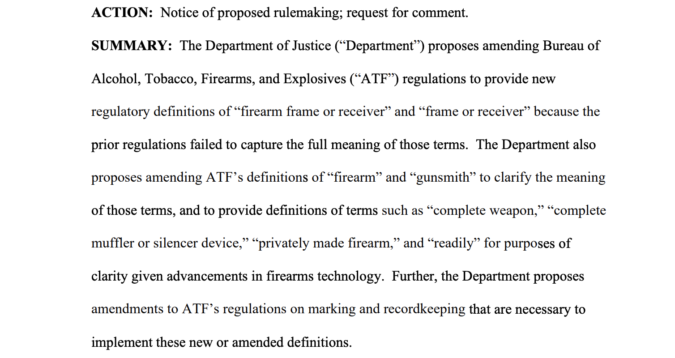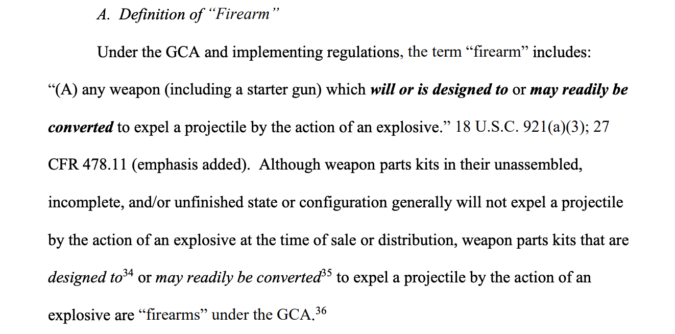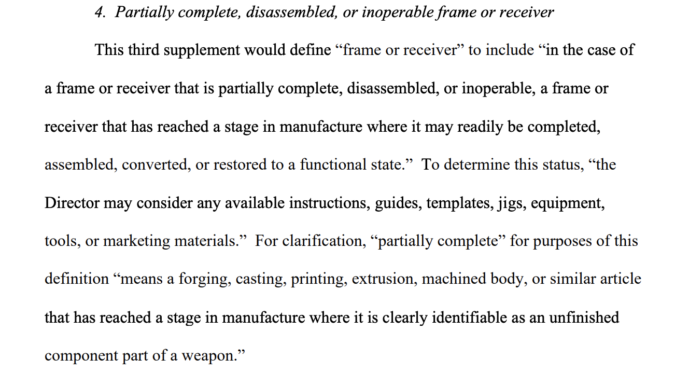Interesting synopsis
Leaked: ATF Documents on 80% Parts
The rights of the American people are apparently under review, as President Biden informed the country just a few weeks ago. Between braces, 80% parts, and red flag laws, the deadlines were set urging the government to come out with clear statements about how they will treat such items in the future. Better said, how they will regulate the rights of the people. The ATF, or AFT depending on who you ask, has been hard at work and the documents regarding their decisions have hardly been kept behind closed doors. Docket No. ATF 2021R-05 is out in the wild and it sets its sights on firearms parts.
In its current form, the 107 page document aims to reconsider what the ATF considers a firearm, a gunsmith, and what it means for a firearm to be “complete.” Attached to the expected verbiage on reclassifying inanimate objects as something deemed too dangerous for other people to have, the document includes a proposal to change how the ATF tracks your data or the things you might want to own.

Starting with definitions, the proposed changes expand what the ATF considers to be a firearm, and thus extends the reach of their enforcement. The wording of the document asserts that the current definitions were written 50 years ago, in a time when revolvers were more popular, and that split-receiver handguns, as in, the semi-automatics well all use, were new on the scene. I guess 1911’s have no longer been around for over 100 years. Something, something Two World Wars.
Clearly referring to privately made firearms as “Ghost Guns,” Doc ATF 2021-05 states that 23,906 of these were reported since 2016, as part of a crime. Since privately made firearms lack serial numbers, they are stated to be more difficult to track. At the same time, without serial numbers, it’s hard for the government to know which unit went missing from the arms room.

The item in question would be 80% receivers, and more specifically, when a single package can be ordered with all the parts needed to complete a firearm. The new proposal would require those selling 80% kits to treat them as firearms, and go through the process of operating under an FFL. Manufacturers of these parts kits will also have to be licensed as firearms manufacturers. In order to purchase a parts kit, the buyer will be required to undergo a 4473.

It follows on to acknowledge that the Gun Control Act did not formerly clarify at what point an object officially becomes a receiver or gun.
While the GCA and implementing regulations define a “firearm” to include the “frame or receiver,” neither delineates when a frame or receiver is created. The crucial inquiry, then, is the point at which an unregulated piece of metal, plastic, or other material becomes a regulated item under Federal law.
Docket No. ATF 2021R-05, Page 30, APR 2021.
Another term requesting further definition is readily, in regards to how readily a piece of material may be converted into a functional firearm. The factors considered are:
(a) time, i.e., how long it takes to finish the process;
(b) ease, i.e., how difficult it is to do so;
(c) expertise, i.e., what knowledge and skills are required;
(d) equipment, i.e., what tools required;
(e) availability, i.e., whether additional parts are required, and how easily they can be obtained;
(f) expense, i.e., how much it costs;
(g) scope, i.e., the extent to which the subject of the process must be changed to finish it; and
(h) feasibility, i.e., whether the process would damage or destroy the subject of the process, or cause it to malfunction.Docket No. ATF 2021R-05, Page 32-33, APR 2021.
The new proposal would require the individual who builds a firearm to engrave a serial number within 7 days of completion. Manufacturers who sell kits that can be readily converted into operating firearms will be required to acquire their FFL to continue business.
The letter openly states that it acknowledges that some businesses will be hurt by this determination, but the industry as a whole will be less impacted.
The document is expected to go public in two weeks, in the early days of May, and will be followed by a 90-day time period where the public is able to comment. As with similar situations with the ATF, comments sent to the ATF must adhere to guidelines, which they provide as follows:
- Federal eRulemaking Portal: ATF recommends that you submit your comments to ATF via the Federal eRulemaking portal at www.regulations.gov and follow the instructions. Comments will be posted within a few days of being submitted. However, if large volumes of comments are being processed simultaneously, your comment may not be viewable for up to several weeks. Please keep the comment tracking number that is provided after you have successfully uploaded your comment.
- Mail: Send Written Comments to:
-
- Andrew Lange, Office of Regulatory Affairs, Enforcement Programs and Services,
- Bureau of Alcohol, Tobacco, Firearms, and Explosives,
- 99 New York Ave. NE,
- Mail Stop 6N-518, Washington DC 20226;
- ATTN: ATF 2021R-05.
- Written comments must appear in minimum 12-point font size (.17 inches), include the commenter’s first and last name and full mailing address, be signed, and may be of any length.
-
- Facsimile: Submit comments by facsimile transmission to (202) 648-9741. Faxed comments must:
- 1. Be legible and appear in minimum 12 point font size (.17 inches);
- 2. Be 8 ½” x 11” paper;
- 3. Be signed and contain the commenter’s complete first and last name and full mailing address; and
- 4. Be no more than five pages long.
- Request for Hearing Any interested person who desires an opportunity to comment orally at a public hearing should submit his or her request, in writing, to the Director of ATF within the 90- day comment period. The Director, however, reserves the right to determine, in light of all circumstances, whether a public hearing is necessary. Disclosure Copies of this proposed rule and the comments received in response to it will be available through the Federal eRulemaking portal, at www.regulations.gov (search for ATF 2021R-05), and for public inspection by appointment during normal business hours at: ATF Reading Room, Room 1E-063, 99 New York Ave. NE, Washington, DC 20226; telephone: (202) 648-8740.
